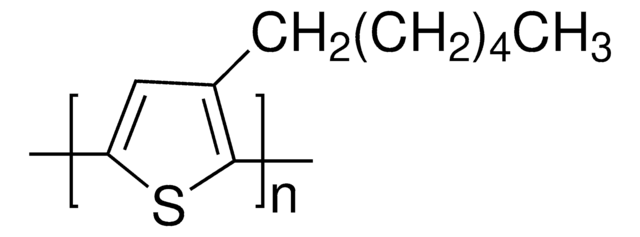772410
PTB7
average Mw 80,000-200,000, PDI ≤3.0
Sinônimo(s):
Poly({4,8-bis[(2-ethylhexyl)oxy]benzo[1,2-b:4,5-b′]dithiophene-2,6-diyl}{3-fluoro-2-[(2-ethylhexyl)carbonyl]thieno[3,4-b]thiophenediyl})
About This Item
Produtos recomendados
descrição
Band gap: 1.84 eV
Nível de qualidade
Formulário
solid
peso molecular
average Mw 80,000-200,000
características do produto alternativo mais ecológico
Design for Energy Efficiency
Learn more about the Principles of Green Chemistry.
sustainability
Greener Alternative Product
solubilidade
chlorobenzene: soluble
chloroform: soluble
dichlorobenzene: soluble
λmax
680 nm (thin film)
Energia orbital
HOMO -5.15 eV
LUMO -3.31 eV
Mw/Mn
2.4 +/- 0.6
PDI
≤3.0
categoria alternativa mais ecológica
, Enabling
Categorias relacionadas
Descrição geral
Aplicação
OPV Device Structure: ITO/PEDOT:PSS/PTB7 :PC71BM/Ca/Al
- JSC = 14.9 mA/cm2
- VOC = 0.75 V
- FF = 0.69
- PCE = 7.4%
Código de classe de armazenamento
11 - Combustible Solids
Classe de risco de água (WGK)
WGK 3
Ponto de fulgor (°F)
Not applicable
Ponto de fulgor (°C)
Not applicable
Escolha uma das versões mais recentes:
Já possui este produto?
Encontre a documentação dos produtos que você adquiriu recentemente na biblioteca de documentos.
Artigos
Organic photovoltaics (OPVs) represent a low-cost, lightweight, and scalable alternative to conventional solar cells. While significant progress has been made in the development of conventional bulk heterojunction cells, new approaches are required to achieve the performance and stability necessary to enable commercially successful OPVs.
Professor Chen (Nankai University, China) and his team explain the strategies behind their recent record-breaking organic solar cells, reaching a power conversion efficiency of 17.3%.
Active Filters
Nossa equipe de cientistas tem experiência em todas as áreas de pesquisa, incluindo Life Sciences, ciência de materiais, síntese química, cromatografia, química analítica e muitas outras.
Entre em contato com a assistência técnica







